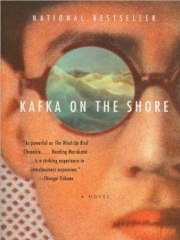Kafka on the Shore by Haruki Murakami
This novel was the 4th Japan-related book I’ve read this summer (along with two nonfiction books and another of Haruki Murakami’s books – Norwegian Wood). I think this is the first time I’ve ever read multiple non-series works by the same author except for Shakespeare. While Kafka on the Shore is much more in the supernatural realm, it shares a surprising number of themes with the more realistic Norwegian Wood.
1. ‘In ancient times people weren’t just male or female, but one of three types: male/male, male/female, or female/female.’
Oshima claims that after God cut people in half, people spent their lives looking for their other halves. At first, this was just an interesting conversation between Kafka and Oshima. But later, Oshima turns out to be a girl who takes on the male gender. It reminds me of Norwegian wood when Reiko suddenly shakes up the book by recounting her unexpected lesbian encounter with her piano student.
2. ‘Um,’ the cat said.
Nakata enters the story speaking to a cat. The scene flips a switch and turns the book into pure whack. Nakata’s conversations with the cats are also my favorite parts.
3. In dreams come responsibilities.
This refers to whether Eichmann deserved to be punished when he simply followed orders. Once again, the statement seems random until later when Kafka sleeps with Miss Seiki and Sakura in his dreams (supposedly his mother and sister).
4. ‘What’s the name of the song?’ ‘Kafka on the Shore’
I had been speculating about the book’s title until this point. Just like Norwegian Wood, which is named after the Beatles song, this book lends its title to a song. Music plays a huge role throughout. For example, Hoshino discovers Archduke Trio and draws parallels between Nakata and Beethoven.
5. ‘My grandpa always said asking a question is embarrassing for a moment, but not asking is embarrassing for a lifetime’ – Hoshino
Yes. Always ask questions.
6. ‘So the prototype for labyrinths is, in a word, guts.’ – Oshima
Best analogy in the book. The complexity is inside you.
7. ‘The only thing I understand is the present.’ – Nakata
This is why Nakata is the best character. He is refreshing because he goes about his business with no worries about the past or future. Miss Seiki is the perfect foil. She is trapped in her past and essentially dies at a young age when her boyfriend dies.
8. ‘Hey there, kitty. Nice day, isn’t it?’ – Hoshino
The life of this overworked, soul-searching truck driver changes dramatically when he decides to go on an adventure with the cryptic Nakata. In the end, after Nakata’s death, he gains the ability to talk to cats. Definitely the character who ends on the highest note.
9. ‘Memory isn’t so important here. The library handles memories.’ – Girl in the forest
That’s why so much of the book takes place inside a library – a symbol of the past.
10. ‘I want you to remember me.’ – Miss Seiko
Exact same line as Norwegian Wood from Naoko to Watanabe. A simple line that summarizes the struggles of both relationships.
Kafka on the Shore is one of the most confusing books I’ve ever read. Talking cats. Johnnie Walker. KFC. Stones. Leeches. Dreams. Crows. When I finished, I thought I hadn’t read carefully enough because there were so many holes in the story. Some things weren’t explained. Others didn’t make sense. But apparently, this is what Murakami wanted.
The first half of the book is riveting, but the story slows down in the second half and ventures into thoughts and philosophies. I enjoyed the alternating chapters of Kafka and Nakata, although I found the Nakata plotline to be much more exciting. I’ll let this book sink in for a bit, then I’ll definitely check out more of Murakami’s books.
